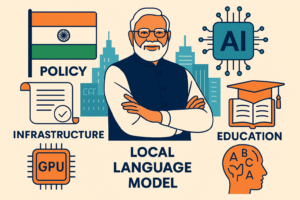Top AI Startups in the World in June 2025
If you’ve been hearing a lot about “AI” lately and wondering what all the fuss is about, you’re not alone. From your smartphone to online shopping, AI—short for Artificial Intelligence—is becoming a part of our everyday lives. Whether it’s Google Maps predicting traffic jams or Netflix recommending what to watch next, there’s a smart computer brain working behind the scenes.
But here’s the cool part: AI isn’t just something big companies like Google or Microsoft are doing. Around the world, a new wave of young, energetic startups is building some seriously mind-blowing tools using AI. These are small teams—often just a few friends with laptops—who are solving problems in ways that feel almost magical.
In this article, we’re going to look at some of the most exciting AI startups in the world as of June 2025. Whether you’re a school student in Mumbai curious about the future, a college kid in Bengaluru looking for inspiration, or just someone fascinated by technology, this list is going to show you what’s possible when people mix imagination with machine learning.
What’s Happening in AI Right Now?
Before we dive into the list, here’s a quick idea of what’s going on. Startups are using AI to:
- Write entire blog posts and movie scripts
- Make customer service feel like you’re chatting with a friend
- Detect diseases early—even before symptoms show up
- Turn your voice into any language or accent
- Help farmers predict weather and increase crop yield
- Create fashion designs, music, or even video games
- Let’s now jump into the top AI startups that are turning heads around the globe.
1. Anthropic (USA)
What they do:
Imagine if you could talk to your computer like it’s your school teacher—but way more patient. That’s what Anthropic is working on. Their AI assistant, Claude, is designed to be helpful, honest, and harmless (yes, those are their three goals).
Why people love it:
Many businesses use Claude to write reports, analyze data, and even summarize legal documents. It’s like having a super-smart buddy who never gets tired.
Real-life example:
A small startup in Delhi uses Claude to draft business emails and contracts in half the time.
2. Mistral AI (France)
What they do:
Mistral builds open-source AI models. That means anyone can use them—free of charge. This is huge for students, researchers, and smaller startups, especially in countries like India where budgets are tight.
Why people love it:
It’s fast, powerful, and doesn’t need massive machines to run.
Real-life example:
A 16-year-old coder in Pune used a Mistral model to build a chatbot for his tuition center that helps kids with math homework.
3. Synthesia (UK)
What they do:
Ever seen a video where it looks like someone is speaking flawless Hindi—even though they don’t know the language? That’s Synthesia. They create AI-generated videos with avatars that can speak any script you write.
Why people love it:
It’s perfect for training videos, ads, or even school presentations. You don’t need cameras or actors—just an idea and a script.
Real-life example:
An ed-tech firm in Hyderabad uses Synthesia to make science videos in five Indian languages using just one English script.
4. Runway (USA)
What they do:
Runway helps people create video content with AI. Want to remove someone from a video or turn a still photo into a full-motion scene? This tool makes it as easy as clicking a button.
Why people love it:
You don’t need editing skills. Artists, YouTubers, and even marketing teams are using Runway to save time and money.
Real-life example:
A fashion influencer in Jaipur uses Runway to turn simple outfit photos into professional-grade reels.
5. Reka AI (USA)
What they do:
Reka creates smart assistants that can understand multiple languages and handle tricky questions—especially useful for businesses that talk to customers all over the world.
Why people love it:
They support multilingual capabilities and focus on being super accurate.
Real-life example:
A logistics startup in Noida uses Reka to offer instant support in Hindi, Tamil, and English without needing a big call center.
6. Glean (USA)
What they do:
Imagine searching through your school notes, old emails, or class assignments with one click. Glean helps companies do exactly that with all their files and data.
Why people love it:
It’s like Google Search, but just for your own work files.
Real-life example:
A Bengaluru software firm uses Glean so new interns can quickly understand past projects by just searching for key terms.
7. Hugging Face (USA)
What they do:
No, it’s not a soft toy brand! Hugging Face is a platform where developers share powerful AI models. Think of it like GitHub, but just for machine learning.
Why people love it:
It’s free, open, and has a huge community of developers around the world.
Real-life example:
A group of college students in Chennai built a mental health chatbot using tools from Hugging Face.
8. ElevenLabs (Poland/USA)
What they do:
These folks make AI-generated voices so real, you might not be able to tell if it’s human or computer. You can clone your voice, make it sound like a cartoon, or even create realistic audiobooks in minutes.
Why people love it:
It’s fast, fun, and super helpful for creators.
Real-life example:
A Marathi podcast creator uses ElevenLabs to generate different voices for characters in her storytelling series.
9. Inflection AI (USA)
What they do:
Inflection created “Pi,” a friendly chatbot that acts like a thoughtful companion. It’s not about getting work done, but about having deeper conversations, like a digital friend who actually listens.
Why people love it:
It’s personal, calming, and different from business-focused AI bots.
Real-life example:
A student in Nagpur talks to Pi to practice spoken English and boost confidence.
10. Sarvam AI (India)
What they do:
Based in Bengaluru, Sarvam AI is building powerful Indian language models. This means AI that can understand and respond in Hindi, Telugu, Kannada, Tamil, and more.
Why people love it:
It’s made for India, by Indians. Sarvam makes it easier for rural users, students, and small businesses to benefit from AI in their mother tongue.
Real-life example:
A government school teacher in Uttar Pradesh uses Sarvam AI to generate lesson plans in Bhojpuri and Hindi.
So, What’s the Takeaway?
AI isn’t just science fiction anymore. It’s here, and it’s being shaped not just by tech giants, but by nimble startups full of smart, curious minds. Whether you’re a student doodling app ideas in your notebook or a young entrepreneur trying to improve your family business, there’s inspiration to be found in these startups.
Some are helping creators. Others are helping businesses work faster. And a few are building tools for fun, connection, or even mental health.
These AI startups are not just changing tech—they’re changing lives.
Frequently Asked Questions
1. Can someone in India use these AI tools?
Yes! Most of these startups offer global access through websites or apps. Some, like Sarvam AI or Mistral, are even more friendly to Indian users.
2. Do I need to know coding to use AI tools?
Not at all. Many AI apps have simple interfaces. If you can use WhatsApp or YouTube, you can probably use these tools too.
3. Are these AI tools expensive?
Some have free versions. Others charge, but it’s usually way cheaper than hiring people for the same work.
4. Can students build something like this?
Absolutely. Many founders started young. If you’re learning Python, AI, or design—keep going. You could be on a list like this one someday!
5. Will AI take away all jobs?
AI might replace some tasks, but it also creates new jobs—like AI trainers, prompt writers, or ethics advisors. It’s all about learning to work with AI, not against it.
Final Thoughts
The world of AI is growing faster than we ever imagined. And what’s most exciting? The next big breakthrough might not come from Silicon Valley—but from a small town in India, where someone like you is tinkering with an idea.
So go ahead. Explore. Play. Learn. Maybe even build. The world of AI is wide open—and it’s waiting for fresh minds like yours.














Post Comment